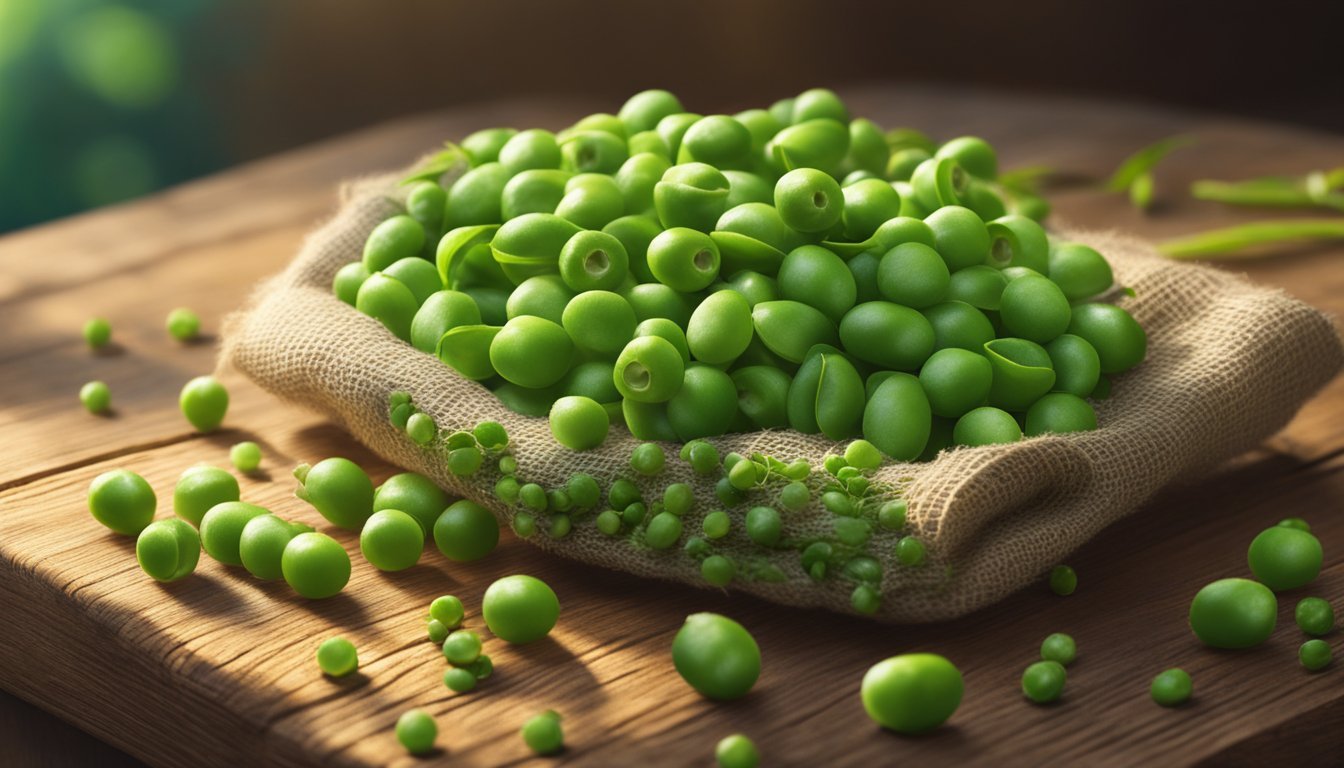10 Foods High in Starch
Essential Staples for Energy and Nutrition
Starch is a significant component of many foods that people consume daily, offering essential energy and nutrients needed for proper bodily functions. These foods, commonly found in both processed and whole forms, play a critical role in dietary habits and overall health.
Understanding the role of starchy foods in a diet can help individuals make informed choices. From grains to vegetables, recognizing their benefits and potential drawbacks is vital for maintaining balanced nutrition. This article explores the presence of starch in various foods, providing insights for those aiming to optimize their dietary intake.
1) Potatoes
Potatoes are among the most well-known starchy foods. They are widely consumed and come in various types, such as russet, red, and sweet potatoes.
Each type of potato has a different starch content and nutritional profile. For example, russet potatoes are high in starch and often used for baking and mashing, while red potatoes have less starch and are firmer, making them ideal for salads.
Potatoes are versatile and can be prepared in many ways. Common methods include baking, boiling, frying, and roasting. This versatility makes them a staple in many cuisines around the world.
Starch content can vary based on how the potatoes are prepared. Cooking methods can also impact the glycemic index, with boiled potatoes having a lower glycemic index compared to baked or fried versions.
Despite their high starch content, potatoes also provide essential nutrients such as vitamin C, potassium, and fiber, particularly when the skins are left on. This makes them a nutritious addition to a balanced diet when consumed in moderation.
2) Corn
Corn is one of the primary sources of starch in the diet. It comes in various forms, including fresh corn, cornmeal, cornstarch, and corn syrup. Each form serves different culinary purposes and offers distinct nutritional benefits.
Fresh corn contains a moderately high amount of starch, yet it is also rich in fiber, vitamins, and minerals. This balance makes it a nutritious option compared to many other starchy foods.
Cornmeal is produced by grinding dried corn kernels. It is commonly used in cooking and baking, particularly for making cornbreads and tortillas. Being naturally gluten-free, it is a suitable choice for those with gluten sensitivities.
Cornstarch is another derivative, often used as a thickening agent in sauces, soups, and desserts. It is almost pure carbohydrate, providing a quick source of energy.
Corn syrup, made from corn starch, is widely used as a sweetener in many processed foods and beverages. However, it is less nutritious due to its high sugar content.
Given its versatility and nutritional profile, corn remains a staple in many diets worldwide. Whether consumed fresh or processed, it offers various benefits depending on its form and preparation.
3) Rice
Rice is a staple food in many cultures around the world. It is highly versatile and can be prepared in numerous ways, making it a popular choice in various cuisines.
White rice is particularly high in starch, which is converted into glucose in the body, providing a quick source of energy.
Brown rice, while also starchy, contains more fiber and nutrients compared to white rice. This makes it a slightly healthier option for those looking to maintain stable blood sugar levels.
Cooking methods can affect rice's starch content. For instance, cooling cooked rice can increase its resistant starch levels, which have benefits for gut health.
Different varieties of rice, such as jasmine, basmati, and arborio, have varying starch contents, influencing their texture and usage in recipes.
4) Bread
Bread is a staple food in many diets around the world and a significant source of starch.
Made primarily from flour, water, and yeast, bread's high starch content comes from the flour, which is typically derived from wheat.
Whole-grain bread is considered a healthier option compared to refined bread, providing more fiber and nutrients like B vitamins, iron, and zinc.
White bread, on the other hand, is often made from refined flour, which is lower in fiber and has a higher glycemic index, leading to quicker spikes in blood sugar levels.
People often use bread in various forms, including toast, sandwiches, and as a side for meals. It is versatile and readily available, making it a convenient choice for many.
Bread’s high starch content makes it an energy-dense food, contributing to daily carbohydrate intake.
When consumed in moderation and paired with protein, vegetables, and healthy fats, bread can be part of a balanced diet.
Opting for whole-grain versions can help enhance the nutritional value while still enjoying this common food.
5) Pasta
Pasta, especially in its refined form, is a significant source of starch. Traditional white pasta is high in starch and low in fiber and nutrients. This makes it a common ingredient in many diets around the world, though its nutritional profile is less desirable for those seeking to limit their starch intake.
Whole-grain pasta presents a more nutritious option. It contains more fiber and protein compared to its refined counterpart. The higher fiber content helps to slow digestion and can lead to better blood sugar control. This makes whole-grain pasta a better alternative for those looking to eat healthier.
Cooking and cooling pasta can increase its content of resistant starch. This type of starch acts more like fiber, promoting beneficial gut bacteria and improving digestion. Resistant starch does not cause a rapid spike in blood sugar, making it a healthier choice for carbohydrate consumption.
Different pasta shapes and sizes do not significantly change the starch content. Whether spaghetti, penne, or fusilli, the primary difference lies in the type of flour used and whether it is refined or whole grain. Choosing whole-grain options and incorporating cooking and cooling techniques can make pasta a part of a balanced diet.
6) Green Bananas
Green bananas are a rich source of resistant starch and pectin, offering several health benefits. These starches are less digestible, which can aid in blood sugar control and promote gut health by acting as prebiotics.
As they ripen, their starches convert to sugars, making them sweeter and less beneficial for those seeking resistant starch.
Protopectin in green bananas converts to digestible fiber, enhancing their dietary fiber content. This makes them a good option for those needing to increase their fiber intake.
Despite their health benefits, many people avoid green bananas due to their taste, preferring ripened ones. However, incorporating them into smoothies or cooked dishes can make them more palatable.
7) Cassava
Cassava is a root vegetable that is a significant source of carbohydrates. It is rich in resistant starch, a type of starch that resists digestion and functions similarly to soluble fiber.
This high-carb food is also a good source of fiber, which can promote satiety and support healthy gut bacteria. The fiber in cassava may help reduce cravings for salty, sweet, and high-fat foods.
Cassava flour, made from the root, is a popular gluten-free alternative to traditional wheat flours. It retains much of cassava's resistant starch content while providing a similar mineral profile to conventional flours.
It is important to note that cassava should not be eaten raw due to the presence of cyanogenic glycosides, which can be toxic if not properly processed. Safe preparation methods include soaking, boiling, and fermenting the root.
Rich in calories, cassava offers an essential energy source. Nutrient-wise, it provides some protein, calcium, and fiber, making it more than just an empty calorie food. Nonetheless, individuals on low-carb diets should consider its high carbohydrate content.
Cassava's versatility in culinary applications and its nutritional benefits make it an important food in many diets around the world.
8) Quinoa
Quinoa, though commonly considered a grain, is a seed from the Chenopodium quinoa plant. It is a powerhouse of nutrients and highly versatile in cooking.
This seed is rich in carbohydrates, about 21% when cooked. It also offers significant amounts of protein and fat compared to other grains, making it a balanced source of macronutrients.
A cup of cooked quinoa, approximately 185 grams, contains 222 calories. It provides 39 grams of carbohydrates, 8 grams of protein, and 4 grams of fat. These macronutrients collectively contribute to its high nutritional value.
In addition to its macronutrient profile, quinoa is packed with vitamins and minerals. It includes notable amounts of magnesium, potassium, iron, and zinc. It’s also a good source of dietary fiber, with 5 grams per cup.
Quinoa contains all nine essential amino acids, making it a complete protein. This is particularly beneficial for vegetarians and vegans seeking plant-based protein sources.
Quinoa is naturally gluten-free, making it an excellent option for those with gluten intolerance or celiac disease. Its versatility allows it to be used in various dishes, from salads to main courses.
Overall, quinoa stands out not just for its nutritional profile but also for its adaptability in numerous culinary applications.
9) Oats
Oats are a staple in many diets due to their high starch content and nutritional benefits. They are a convenient and versatile ingredient, making them an easy addition to daily meals.
Oats contain a specific type of starch that has a higher fat content and a greater ability to bind with water. This unique property makes oats particularly filling and satisfying.
Resistant starch is abundant in oats, contributing to digestive health. This type of starch passes through the stomach and small intestine undigested, reaching the colon, where it feeds beneficial gut bacteria.
There are various ways to incorporate oats into the diet. Overnight oats, for instance, involve soaking oats in liquid overnight, which increases their resistant starch content. Another popular choice is muesli, a mix of oats, seeds, nuts, and dried fruit.
Oats are not only nutritious but also provide a good source of energy. They support sustained energy levels throughout the day, owing to their complex carbohydrates and fiber content. Their ease of preparation and health benefits make oats a popular choice in many households.
10) Peas
Peas are a notable example of starchy vegetables. Each half-cup serving contains a substantial amount of carbohydrates, making them a valuable energy source.
Green peas, in particular, are rich in essential nutrients. They provide fiber, vitamins such as vitamin C and K, and minerals like manganese. This nutrient profile contributes to their health benefits.
Peas also contain protein, unlike many other starchy vegetables. This makes them a versatile addition to meals, supporting muscle maintenance and overall well-being.
When cooked, peas retain a slightly sweet taste and soft texture. They can be enjoyed in various dishes, from soups to salads. Their natural sweetness and versatility make them a favorite in many cuisines.
Nutritional Benefits of Starch-Rich Foods
Starch-rich foods offer numerous nutritional benefits. They serve as a primary energy source and provide important dietary fiber.
Energy Source
Starch is a complex carbohydrate found in many plants, including grains and vegetables. It acts as a significant energy source for the body. When consumed, starch is broken down into glucose, which is then used by the body for immediate energy or stored for later use.
Athletes and active individuals often rely on starch-rich foods to fuel their activities and maintain stamina.
Certain starchy foods, like potatoes and corn, are particularly effective at replenishing glycogen stores post-exercise. This helps in faster recovery and sustained energy levels. Including a variety of starchy foods ensures a steady and reliable energy supply throughout the day.
Dietary Fiber
Many starch-rich foods also contain dietary fiber, which is crucial for digestive health. Foods like whole grains, legumes, and starchy vegetables provide both soluble and insoluble fiber.
Soluble fiber can help lower cholesterol levels, aiding heart health.
Insoluble fiber supports regular bowel movements and prevents constipation. Fiber-rich starchy foods can create a feeling of fullness, which aids in weight management by reducing overall calorie intake. Varieties such as brown rice, whole wheat, and barley are excellent for incorporating more fiber into the diet.
Balancing these starch-rich foods with a mix of other nutrients can promote a healthy and well-rounded diet.
Health Considerations
High-starch foods impact both digestive health and blood sugar levels, which are critical factors to consider when integrating these foods into a balanced diet.
Digestive Health
Consuming foods high in starch can significantly influence digestive health. Starches, especially resistant starches found in foods like oats and legumes, play a beneficial role. Resistant starch reaches the large intestine undigested, serving as food for beneficial gut bacteria, promoting a healthy gut microbiome.
These beneficial bacteria produce short-chain fatty acids, which can reduce inflammation and improve gut function.
However, excess consumption of high-starch foods may lead to digestive issues for some people. Symptoms such as bloating, gas, or discomfort can occur. It is important to balance high-starch foods with those rich in fiber, such as vegetables and whole grains, to support optimal digestive health.
Blood Sugar Levels
High-starch foods can cause fluctuations in blood sugar levels, which is particularly important for individuals managing diabetes or insulin resistance. Simple starches, found in foods like white bread and pastries, are quickly broken down into glucose, leading to rapid spikes in blood sugar.
Complex starches, present in whole grains and legumes, digest more slowly and cause a gradual increase in blood sugar.
To manage blood sugar levels effectively, it is beneficial to choose whole, unprocessed starchy foods. Pairing these foods with protein, healthy fats, and fiber can further stabilize blood sugar responses. Monitoring portion sizes and the glycemic index of foods can help maintain more consistent blood sugar levels.
Cooking with Starch-Rich Foods
Cooking with starch-rich foods offers a variety of methods to enhance their nutritional value and optimize their texture and flavor. Different preparation techniques can influence the starch content and the overall health benefits of these foods.
Preparation Methods
Boiling is a common method for cooking foods like potatoes, pasta, and rice. This method can be straightforward but can also lead to nutrient loss if not done correctly. Steaming is an alternative that preserves more vitamins and minerals.
For foods like cornmeal and beans, baking may enhance their flavor and reduce the glycemic index. Cooling foods after cooking, such as rice, can increase the resistant starch content, which benefits gut health.
Experimenting with different cooking techniques can add variety to meals while improving the health benefits of starch-rich foods.




